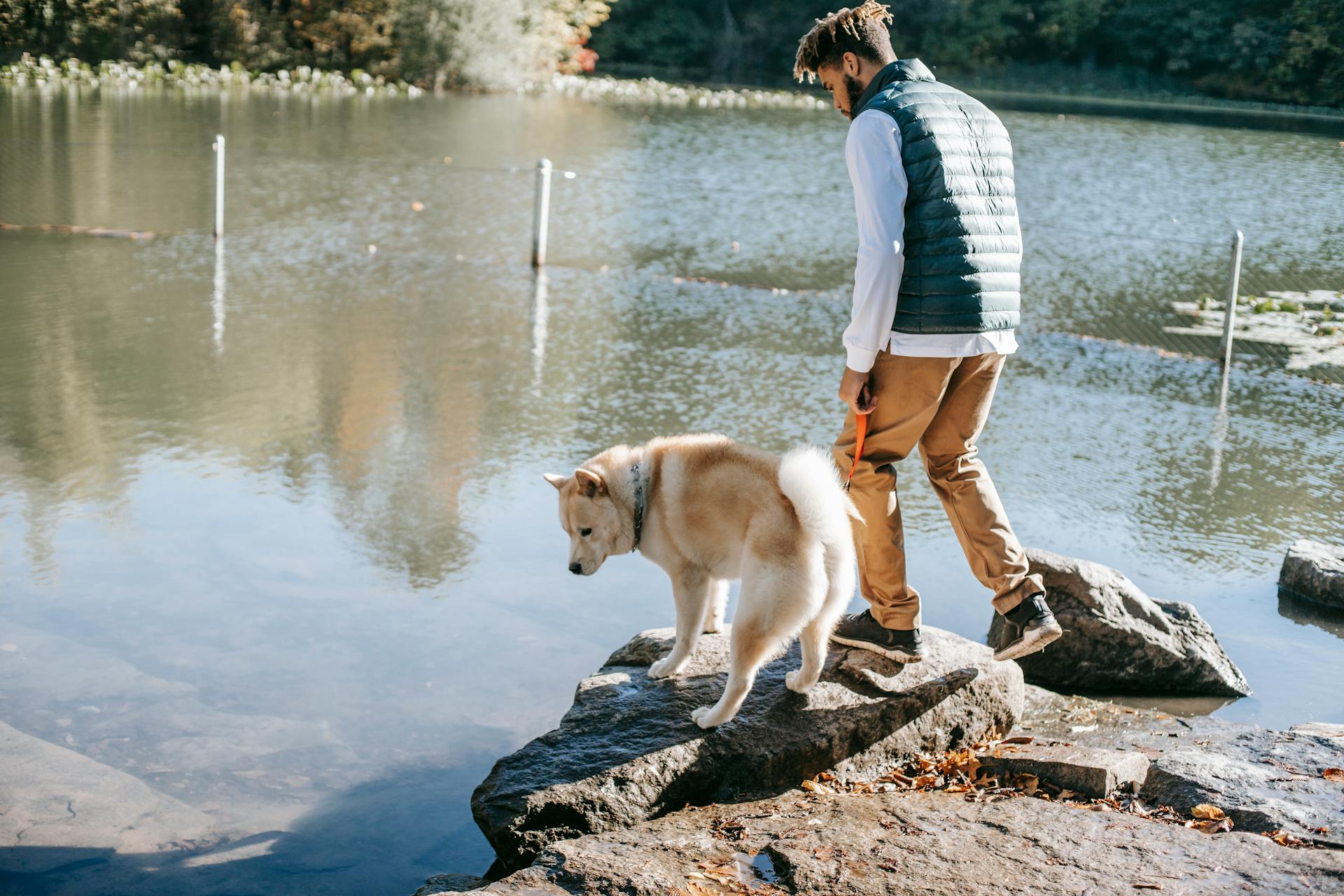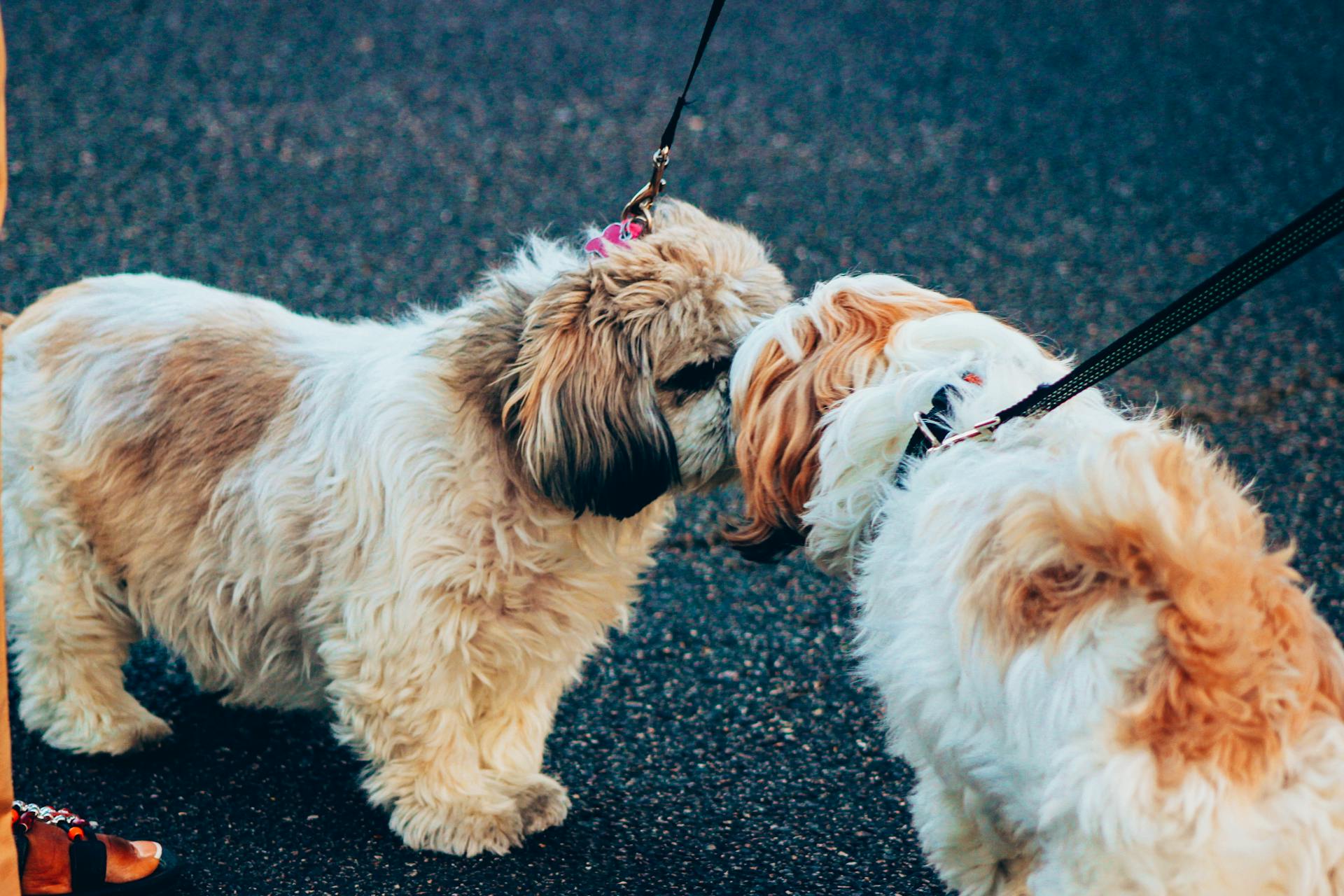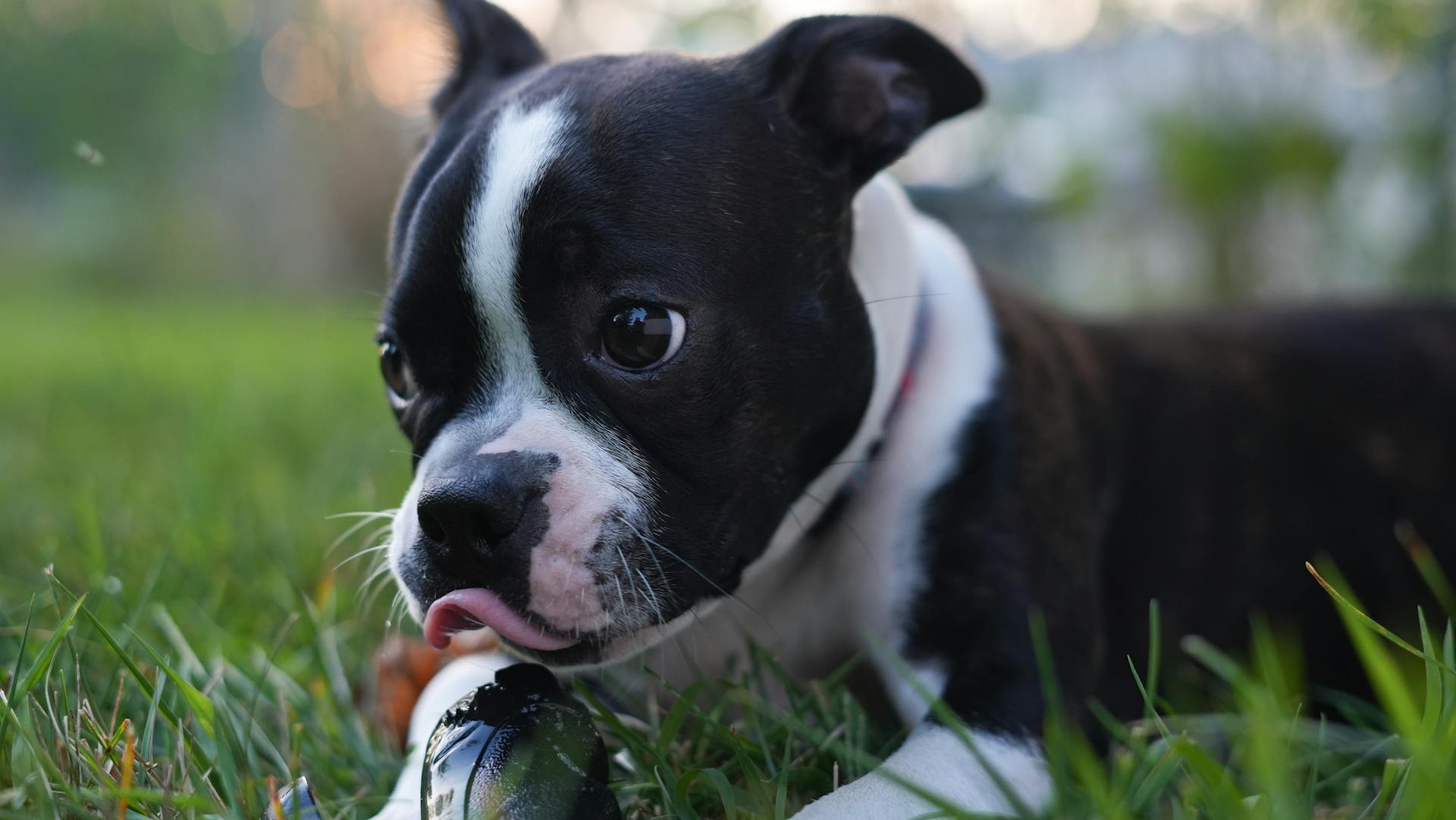
Understanding body language with dogs is crucial for building a strong relationship with your furry friend. Dogs primarily communicate through body language, with a wagging tail often indicating excitement or happiness.
A relaxed dog will typically have a loose, open posture, with their ears up and tail wagging. This is in stark contrast to a tense dog, who will often display a stiff, closed posture with their ears back and tail tucked between their legs.
By paying attention to these subtle cues, you can better understand your dog's emotional state and respond accordingly. For example, if your dog is feeling anxious or stressed, a calm and gentle approach can help to alleviate their fears.
Intriguing read: Breeds of Dogs with Pointy Ears
Understanding Canine Body Language
Dogs communicate primarily through body language and vocals. They use their body posture, facial expressions, and tail wags to convey emotions and intentions.
To become a better pet parent, it's essential to learn the basics of dog body language and "doggie culture." This will help you understand your dog's emotions and intentions, recognize warning signs of stress, anxiety, fear, or aggression, and strengthen your bond with your pup.
Dogs are more likely to feel stress or fear around new situations and new people, so consider the situation when interpreting their body language. Check their overall body posture: are they tense or relaxed? Are they standing tall or lowering their body to the ground?
A dog's facial expressions can also reveal their emotions. Look at their ears, eyes, mouth, teeth, and head for clues. For example, if their ears are back or their whites of eyes are showing, it may indicate fear or anxiety.
Tail wags can also convey different emotions. Dogs wag their tails at different speeds and amplitude to express different emotions. A high, rapid wag may indicate excitement, while a low, slow wag may indicate fear or submission.
Dogs also use vocals to communicate. Listen for barking, howling, growling, or whimpering to understand their emotions and intentions.
Here are some common signs that your dog needs space:
- Tail is tucked between legs or high over the back
- Hair is standing on end
- Growling
- Barking
- Hiding behind you
- Avoiding physical contact
- Whites of eyes showing
By paying attention to these signs and understanding canine body language, you can better navigate situations and predict future behaviors, reducing incidents of dog bites or attacks and strengthening your bond with your pup.
Context and Environment
Dogs use their body language and facial expressions to communicate a range of emotions. They can convey a whole range of emotions with those signals.
Dogs are complex creatures, and their behaviors contain nuances and subtleties. Many pet parents misinterpret their dog's signals because they don't look at the complete context.
To get the full context and understand what your dog is trying to tell you, you need to look at the whole picture. This includes observing every inch of your dog's body language and expressions.
A growl from your dog can have different meanings in different situations. It can be a warning sign or a threat, or it can be a sign of playfulness during playtime.
A dog who is tense and stiff is likely to be feeling anxious or stressed, whereas a loose and wiggly dog is probably feeling relaxed and happy.
See what others are reading: Why Does a Dogs Tail Wag
Facial Expressions
Dogs often use facial expressions to communicate with us, and understanding what they mean can help you build a stronger bond with your furry friend. If a dog is avoiding eye contact, they're likely feeling anxious, afraid, or trying to convey that they're not a threat.
By paying attention to these subtle cues, you can better understand your dog's emotional state and respond in a way that makes them feel more comfortable.
Mouth
Your dog's mouth can reveal a lot about their emotional state. A relaxed dog's mouth is typically closed, but if their lips are tight and stiff, it's a sign they're feeling scared, anxious, or may increase to aggression.
Showing front teeth can be a bit tricky to read, as it can indicate both fear/anxiety and appeasement. However, if your dog is showing all their teeth, including side and back teeth, it's a clear sign of aggression.
A dog's tongue can also give away their emotions. If their tongue is peeking out of their mouth, it's likely a sign they're feeling relaxed and comfortable. But if their tongue is hanging very far out of their mouth, accompanied by panting, it may indicate they're feeling stressed.
Here are some common mouth-related behaviors to look out for:
- Tight/Stiff Lips: Scared, anxious, or may increase to aggression
- Showing Front Teeth: Fear/anxiety or appeasement
- Showing All Teeth: Aggression
- Licking: Friendly, but excessive licking can be a sign of fear, stress, or pain
- Tongue Peeking Out: Relaxed and comfortable
- Tongue Hanging Out: Stressed and may need assistance
People with Open Mouths
A person with an open mouth is often seen as being surprised or shocked. This expression is a natural response to unexpected news or events.

Open mouths are also associated with fear or anxiety, as seen in the example of a person watching a horror movie.
The open mouth expression can be involuntary, as it is a reflexive response to a sudden or intense stimulus.
In some cultures, an open mouth is considered a sign of respect or humility, as it shows a willingness to listen and learn.
This expression is often seen in people who are trying to process complex information or emotions.
A different take: Black Mouth Cur Pitbull Mix Puppy
Facial Expressions
Facial expressions can tell us a lot about how our dogs are feeling. A dog avoiding eye contact is likely feeling anxious, afraid, or trying to convey that they're not a threat.
Direct eye contact, on the other hand, can be a sign that your dog is on high alert and may possibly become aggressive. In a trusting relationship, your dog may also stare or make direct eye contact with you, but in this case, it would mean your dog feels comfortable with you and loves you.
A dog's eyes can also be a giveaway to their emotions. If you see white in your dog's eyes or their pupils have gotten really big, it's a sign of fear. Your dog is feeling scared or anxious.
Here are some common eye expressions to look out for:
A dog with relaxed eyelids, or "soft eyes", is typically feeling comfortable and relaxed. You also probably won't be able to see much of the whites of their eyes, and their pupils will be fairly small in standard lighting.
Pet Perceptions
Your dog can pick up on your emotional state through body language, and it's not always what you expect. If you're feeling sad, your dog may interpret your over-cuddling as confusing and react with attention-seeking behaviors like barking or pawing.
Your pet can sense when you're feeling irritated, even if you think you're hiding it. Their sensitive noses can pick up on the changes in your body language, and they may become timid and sheepish in response.
You might like: Pick of the Litter (film)
An animated you can be over-stimulating for your dog, causing them to become excitable and jump up. This is especially true if you're waving your hands about and using a higher tone of voice.
Your dog needs an outlet for their excess energy, so make sure they get plenty of exercise to burn off their excitement and energy.
Related reading: When Do Dogs Lose Puppy Energy
Posture and Body Position
A dog's posture and body position can say a lot about their mood and emotions. A dog holding their tail in a neutral position is relaxed, but it's essential to note that tail position can vary depending on the breed.
Observing your dog's tail position regularly can help you notice any changes that may indicate a shift in mood. A tail held high can mean the dog is feeling alert, excited, or focused, but be cautious if the tail is stiff, as it might be a sign of preparation to fight.
A dog with their head down or lowered is likely feeling uncomfortable, and this can be a subtle sign. Sometimes, a dog will simply turn their head to the side, which is an example of appeasement behavior.
See what others are reading: Why Are My Dog's Nails Splitting?
Head Held High
A dog holding their head high could be walking around in their normal, relaxed resting state.
However, if the dog looks rigid and stiff, they may be on high alert, perhaps feeling frightened or threatened by something around them.
It's not uncommon for dogs to display this behavior in new environments or when meeting new people, so it's essential to pay attention to their body language.
A tense dog who is standing in a rigid posture is usually feeling uncomfortable, scared or stressed.
Approach them with caution and contact your veterinarian if you suspect your pup is sick or injured.
Broaden your view: New Legendary Dogs Pokemon
Head Bowed
A dog with their head down or lowered is likely feeling uncomfortable. Sometimes this is subtle, just a slight turn of their head to the side.
This can be what's known as appeasement behavior, meaning the dog tries to avoid conflict by lowering their head.
For more insights, see: Idiopathic Head Tremor in Dogs
Raised Hackles
Raised hackles are a clear sign that your dog is feeling excited or scared. The hairs on their back stick up due to a reflex called piloerection.
This reflex is not unique to dogs, by the way - humans experience it too, often manifesting as goosebumps when we're nervous or scared.
Paw Lifting
Dogs often lift their paws in anticipation, whether it's for a treat or to defend themselves. This behavior can be a sign of excitement or caution, and it's essential to consider the context.
Some dogs lift their paws in preparation to receive a treat, showing they're eager for a reward.
Behavioral Cues
Dogs communicate their emotions and intentions through various body language cues. A relaxed dog is likely to have a loose, wiggly body, semi-closed, squinty eyes, and a wagging tail.
Other signs of a comfortable dog include relaxed, neutral ears and a loosely-moving body. If your dog is showing these behaviors, they're ready to meet someone new.
A dog that's feeling stressed or anxious may exhibit a range of behaviors, including licking lips, ears back, and a mouth closed with a still body. These signs indicate that your dog needs some space and shouldn't be greeted by someone new.
Here are some key behavioral cues to look out for:
By paying attention to these behavioral cues, you can better understand your dog's emotions and intentions, and respond in a way that's supportive and comforting.
Signs of Discomfort
If your dog is showing signs of discomfort, it's essential to give them space and time to get comfortable. A dog's body language can tell you a lot about their emotional state, and recognizing these signs can help you prevent stress and anxiety in your furry friend.
A dog that's licking its lips or has its ears back is likely feeling uncomfortable around someone. If your dog's mouth is closed and their body is still, it's a sign that they're not feeling relaxed. A furrowed brow can also indicate stress or anxiety in dogs.
Some other signs of discomfort in dogs include a lowered tail base, a lifted paw, yawning, dilated pupils, and rolling over. These behaviors are all warning signs that your dog needs some space and time to get comfortable.
Here are some specific behaviors to look out for:
- Tail tucked between legs or high over the back
- Hair standing on end
- Growling
- Barking
- Hiding behind you
- Avoiding physical contact
- Whites of eyes showing
If you notice any of these behaviors, it's best to give your dog some space and let them come to you when they're feeling more comfortable. By paying attention to your dog's body language, you can help prevent stress and anxiety in your furry friend.
Check Dog's Greeting Readiness
If your dog's body is loose and wiggly, with a mouth that's open and relaxed, they're ready to meet new people. This is especially true if they're moving or leaning toward the person.
Relaxed, neutral ears and a loosely-moving body are also signs that your dog is comfortable and ready to make friends. They might even show off a bit, with their bottom wiggling as they get excited.
To determine if your dog is open to a greeting, observe their body language. If their body is tense with little movement, it's best to give them some space. On the other hand, if their body is loose and wiggly, they're probably ready to meet the other person.
Here are some key signs to look out for:
- Loose, wiggly body
- Open mouth and relaxed expression
- Relaxed, neutral ears
- Loosely-moving body
- Bottom wiggling
If you notice any of the following signs, it's best to give your dog some space and let them come to you: a tense body, a closed mouth, or a furrowed brow.
Playfulness
Playfulness is a key aspect of a dog's behavior, and it's essential to recognize the signs that indicate they're ready to play. A play bow, where a dog stretches their front legs and leans on their elbows, is a clear invitation to play.
Dogs often accompany this invitation with excited barking or playful attacks and retreats. This behavior is not meant to be threatening or challenging, but rather a way to initiate play.
To encourage playfulness, try teaching your dog an "off" or "leave it" exercise and reward them with small tidbits of food. This can help decrease or eliminate any previous rough behavior.
A dog's playful posture is another clear sign they're ready to play. This includes lowering their front body, sticking their booty in the air, and possibly jumping and twisting. You may also notice their ears held backward, tail held high but loose, and open-mouth panting or light playful biting.
Broaden your view: Dog Play Daycare
Snapping
Snapping is a clear warning sign that a dog needs space. If a dog snaps their jaws or makes a biting motion in the air, they're telling you to back off.
Dogs usually won't miss their target if they want to bite, so an air snap is a serious signal to give them space before they escalate.
For another approach, see: Laika Space Dog Breed
Dominant Aggressive
Dominant Aggressive animals are very confident and will express their social dominance. They also send a clear message that they're willing to act aggressively if challenged.
Knowing whether your dog is dominant or submissive can help your relationship with your dog. This awareness can also make you more aware of how other dogs around you may act.
Consider reading: Dominant Dog Body Language with Other Dogs
Frequently Asked Questions
How to tell if your dog loves you?
Does your dog show affection, follow you everywhere, and prioritize your presence over food? If so, it's likely a sign that your dog loves and adores you.
What is an aggressive dog's body language?
An aggressive dog's body language includes a stiff posture and forward stance, often accompanied by bared teeth, growling, and barking. If you notice these signs, it's essential to understand what they mean and how to respond safely.
What is an unhappy dog's body language?
An unhappy dog's body language may include a tucked tail, rather than a wagging one. This subtle sign can indicate stress or unhappiness, even if the tail appears to be wagging.
How do you read what your dog is saying?
Read your dog's body language by paying attention to their tail and ear positions, which can indicate emotions like contentment, excitement, or alertness
What is your dog trying to tell you?
Your dog's body language is communicating their emotional state, with a down or tucked tail indicating fear or stress, and a held-high tail suggesting confidence or aggression. Understanding these cues can help you better connect with and care for your furry friend.
Sources
- https://be.chewy.com/decoding-dogs-body-language/
- https://www.petplan.co.uk/pet-information/dog/advice/dog-communication-reading-human-body-language/
- https://moderndogmagazine.com/articles/how-to-read-your-dogs-body-language/
- https://www.animalhumanesociety.org/resource/whats-your-dogs-body-language-saying
- https://post.bark.co/health/dog-body-language-guide/
Featured Images: pexels.com


